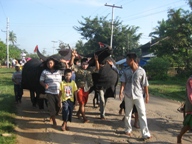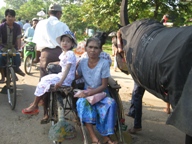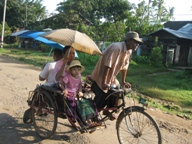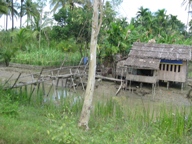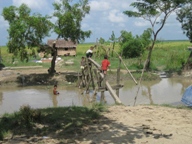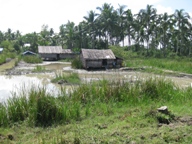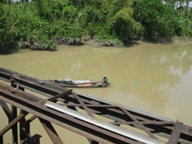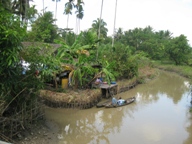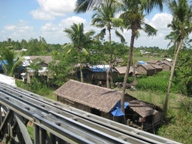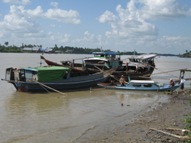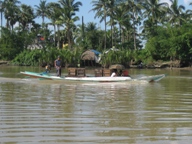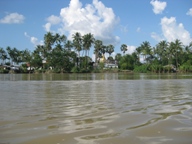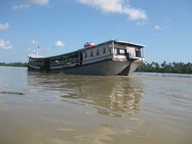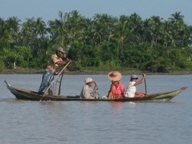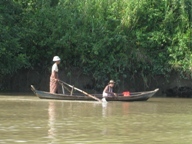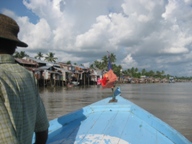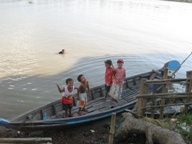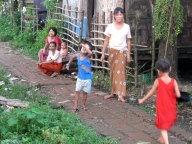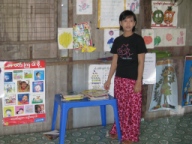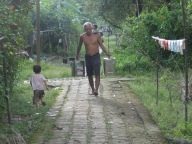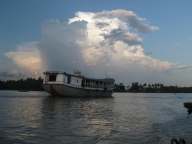(Usually all the pictures here are mine, but videos and a few pictures taken by board member Hector Rivas were too good to leave out in this and a few following posts. Click on active words in the text to view the videos.)
We took a two day trip in a van to the city of Bogalay which is in the north east part of the southern delta area. We visited libraries and some monastery schools there and in the surrounding area. The highlight of this trip was traveling by a small boat which just held our group to riverside villages in the area. There we again learned about education and libraries in the more outlying areas.
If you’re looking for Bogalay you might try spelling it “Bogale” also. Some spell checkers, and Google maps spells it that way.
The delta area of Myanmar was devastated by cyclone Nargis over a year and a half ago. Most buildings in this area at least lost their roofs if they were not entirely flattened. A lot of rebuilding has occurred in the last year and a half. In some ways it is easier here than other more developed parts of the world since there is less complexity to be rebuilt. Still, we heard stories of how hard it was for children to come back to school and study after they had lost most of their families, their homes, or whatever else a child might have to lose.
The trip down was made by van on the handmade roads of Myanmar. These are made from one to three inch rock placed by hand and then rolled. Because of the rocks they are bumpy in a way that makes a lot of noise and must be wearing on the car, but does not shake the passengers. Potholes do not seem to develop in these type roads. I think if they can put good layer of asphalt over such a base they’ll have some long lasting roads. We saw very few cars, buses and motorbikes but a lot of bicycles and bicycle taxis. At one point we ran head on into a Buddhist Ka-htain donation celebration on the road and had to stop. Men were in buffalo costumes (see video) and other men “fought” them. Ka-htain marks the end of 3 months of Waso (Buddhist Lent) in which monks are not allowed to travel. The monks are now back out and receiving offerings.
The view was countryside most of the time. Many of the photos here were “drive by” from a moving car, so please forgive the tilt and maybe lack of clarity. Often there would be a canal near the road so that access to homes was via a log bridge. This is the delta area, so we went over a number of small and some large bridges. I tried to get these water areas as we passed.
The river trip was made in a small boat shown in the first picture below. It was provided by friends and education/library supporters U Aung Nyunt and his wife Daw Kyin Nu. We started out inside (see video) but soon got outside to better enjoy the scenery (see another video). Most small boats that are powered in Myanmar use a small Chinese once cylinder diesel engine with a long propeller shaft. I guess you could call it an outboard motor, but it is far simpler and cheaper (from $150 to about $300 for larger engines) than an outboard you would buy in the U.S. We traveled a few hours past many colorful boats to the river village Myin Ka Gone. The village had a row of houses along the river, and then a walkway which I think was its main thorofare. It may not have had road access, since this and a few other walkways were all we saw. One of the last pictures you see is a kindergarten teacher standing next to the school library. We plan to help them out.
As we went on this and other expeditions in Myanmar, people from the local area helped us a great deal along the way. In Myanmar the people are always the best part.
